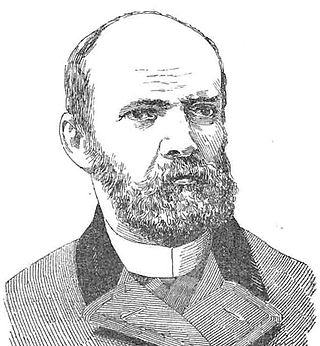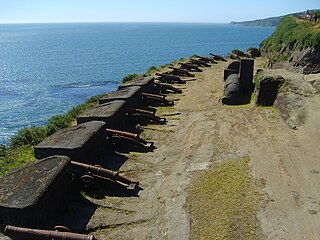This article needs additional citations for verification .(March 2019) |
| |||||
| Decades: | |||||
|---|---|---|---|---|---|
| See also: | |||||
The following lists events that happened during 1907 in Chile.
This article needs additional citations for verification .(March 2019) |
| |||||
| Decades: | |||||
|---|---|---|---|---|---|
| See also: | |||||
The following lists events that happened during 1907 in Chile.

Diego Jacinto Agustín Barros Arana was a Chilean professor, legislator, minister and diplomat. He is considered the most important Chilean historian of the 19th century. His main work General History of Chile is a 15-volume work that spanned over 300 years of the nation's history.

The royal governor of Chile ruled over the Spanish colonial administrative district called the Captaincy General of Chile, and as a result the royal governor also held the title of a captain general. There were 66 such governors or captains during the Spanish conquest and the later periods of Spanish-centered colonialism. Since the first Spanish–Mapuche parliaments in the 17th century it became an almost mandatory tradition for each governor to arrange a parliament with the Mapuches.

This is a timeline of Chilean history, comprising important legal and territorial changes and political events in Chile and its predecessor states. To read about the background to these events, see History of Chile. See also the list of governors and presidents of Chile.

Instituto Nacional General José Miguel Carrera, often shortened to Instituto Nacional, is a public middle and high school in downtown Santiago, Chile which teaches 4.400 students between 7th and 12th grade. 170 teachers are employed.

The Fort System of Valdivia is a series of Spanish colonial fortifications at Corral Bay, Valdivia and Cruces River established to protect the city of Valdivia, in southern Chile. During the period of Spanish rule (1645–1820), it was one of the biggest systems of fortification in the Americas. It was also a major supply source for Spanish ships that crossed the Strait of Magellan.
Francisco Antonio de Acuña Cabrera y Bayona was a Spanish soldier and governor of the Captaincy General of Chile between 1650 and 1656. He was son of Antonio de Cabrera y Acuña y de Agueda de Bayona, who was a knight of the Order of Santiago and a professional military man. After serving in Flanders and France, he went to Peru as Maestre de Campo of El Callao and a general, being designated later Royal Governor of Chile. He was married to Juana de Salazar.
The royal governor of Panama ruled over the Spanish colonial administrative district known first as the colony of Darién and later as the colony of Castilla de Oro, which in 1529 was renamed Panamá. This district was subordinated to the Viceroyalty of New Granada on August 20, 1739. There were 113 such governors or presidents during the Spanish conquest and the later periods of Spanish-centered colonialism.

Guerra a muerte is a term coined by Benjamín Vicuña Mackenna and used in Chilean historiography to describe the irregular, no-quarter warfare that broke out in 1819 during the Chilean War of Independence.

Martina Mercedes Eugenia Barros Borgoño Lucia was a Chilean writer and a forerunner of feminism in Chile.
Events in the year 1830 in Chile.

The Dutch expedition to Valdivia was a naval expedition, commanded by Hendrik Brouwer, sent by the Dutch Republic in 1643 to establish a base of operations and a trading post on the southern coast of Chile. With Spain and the Dutch Republic at war, the Dutch wished to take over the ruins of the abandoned Spanish city of Valdivia. The expedition sacked the Spanish settlements of Carelmapu and Castro in the Chiloé Archipelago before sailing to Valdivia, having the initial support of the local natives. The Dutch arrived in Valdivia on 24 August 1643 and named the colony Brouwershaven after Brouwer, who had died several weeks earlier. The short-lived colony was abandoned on 28 October 1643. Nevertheless, the occupation caused great alarm among Spanish authorities. The Spanish resettled Valdivia and began the construction of an extensive network of fortifications in 1645 to prevent a similar intrusion. Although contemporaries considered the possibility of a new incursion, the expedition was the last one undertaken by the Dutch on the west coast of the Americas.
The following lists events that happened during 1846 in Chile.
The following lists events that happened during 1908 in Chile.
The following lists events that happened during 1909 in the Republic of Chile.
The following lists events that happened during 1910 in Chile.
The battle of Río Bueno was fought in 1654 between the Spanish Army of Arauco and indigenous Cuncos and Huilliches of Fütawillimapu in southern Chile. The battle took place against a background of a long-running enmity between the Cuncos and Spanish, dating back to the destruction of Osorno in 1603. More immediate causes were the killing of Spanish shipwreck survivors and looting of the cargo by Cuncos, which led to Spanish desires for a punishment, combined with the prospects of lucrative slave raiding.
The Mapuche uprising of 1655 was a series of coordinated Mapuche attacks against Spanish settlements and forts in colonial Chile. It was the worst military crisis in Chile in decades, and contemporaries even considered the possibility of a civil war among the Spanish. The uprising marks the beginning of a ten-year period of warfare between the Spanish and the Mapuche.
The 1651 wreckage of San José and the subsequent killings and looting carried out by indigenous Cuncos was a defining event in Colonial Chile that contributed to Spanish–Cunco tensions that led to the Battle of Río Bueno and the Mapuche uprising of 1655.